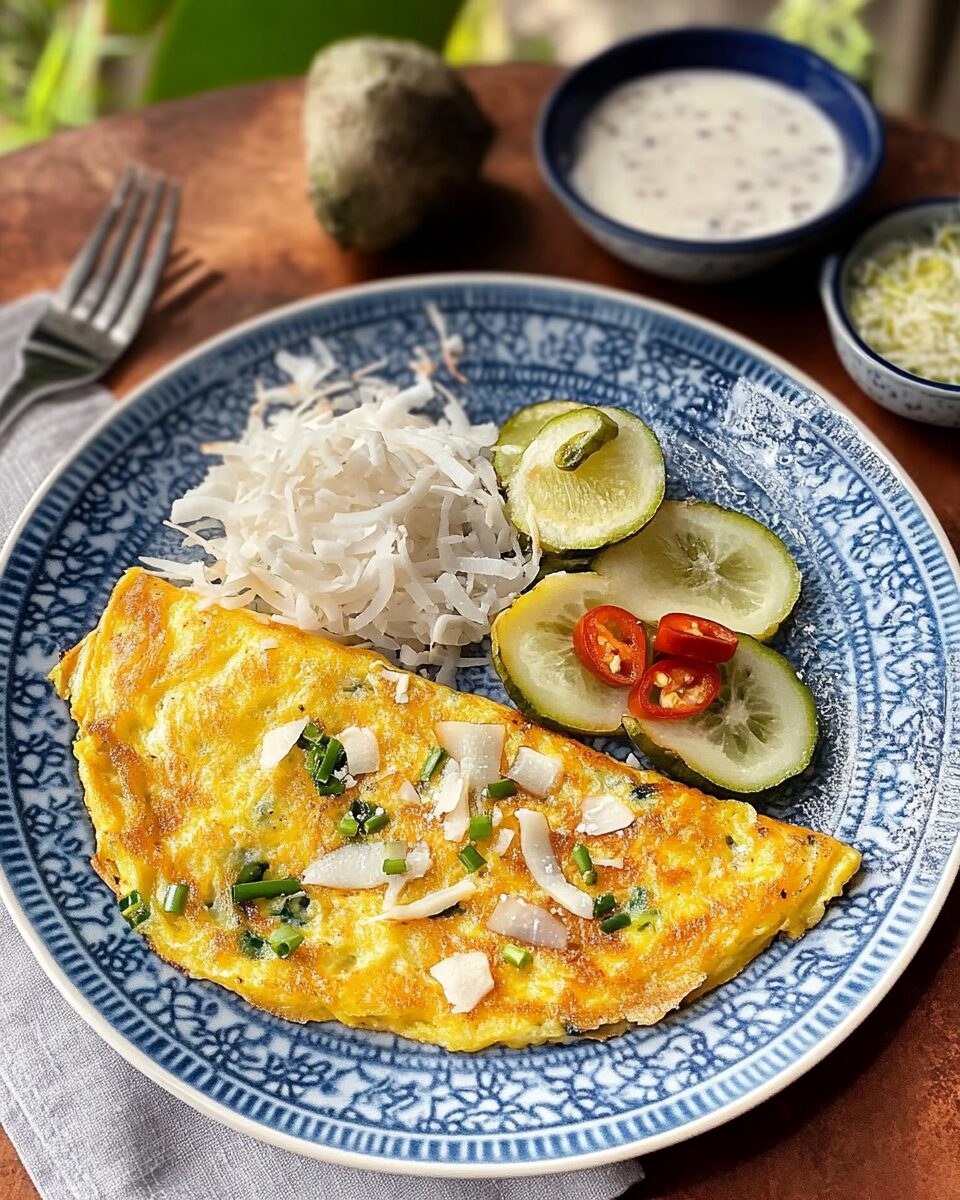The Motta Porrichu is a beloved Kerala-style omelette that brings warmth and spice to your table with the rich depth of coconut cream, curry leaves, and fresh ginger. It’s bold, aromatic, and quick to make—ideal for busy mornings or a light dinner.
Traditionally served with matta rice and pickles, this dish is comfort food at its finest. The crispy edges, soft center, and a blend of fiery chili and sweet coconut make it a nostalgic favorite for many South Indian households.
Full Recipe:
-
4 large eggs
-
1/3 cup coconut cream (from the top of a can of full-fat coconut milk, or canned coconut cream)
-
1 small red onion, diced (about 1 1/2 cups)
-
2 tablespoons grated fresh ginger
-
2 tablespoons fresh curry leaves, roughly chopped
-
1 green bird’s eye chili, finely chopped (or green serrano chili)
-
1 1/2 teaspoons pink salt (or 1/2 teaspoon table salt)
-
1 1/2 teaspoons freshly ground black pepper
-
1 1/2 tablespoons virgin coconut oil
-
Matta rice, for serving (optional)
Directions:
-
In a medium bowl, whisk the eggs until the yolks and whites are fully combined.
-
Add the coconut cream and whisk again, breaking up any clumps until smooth.
-
Mix in the diced onions, grated ginger, chopped curry leaves, chili, salt, and pepper. Stir well.
-
Heat a large nonstick skillet over medium heat and add coconut oil, spreading it evenly.
-
Pour the egg mixture into the pan and spread it evenly with a spatula. Cook uncovered for 2 minutes.
-
Cover the pan and continue cooking for another 3 minutes until the underside is golden brown.
-
Slice the omelette into quarters using the edge of your spatula and flip each piece.
-
Cover and cook for another 2 minutes until golden brown on both sides and fully set.
-
Serve hot with matta rice or enjoy on its own. Leftovers can be stored in the fridge for up to a day.
Prep Time: 10 minutes | Cooking Time: 10 minutes | Total Time: 20 minutes
Kcal: 504 kcal per serving | Servings: 2
A Traditional Taste of Kerala: Motta Porrichu
Motta Porrichu, which literally translates to “fried egg” in Malayalam, is a humble yet flavor-packed dish that holds a special place in Kerala’s rich culinary heritage. This spicy coconut-ginger omelette is more than just a breakfast staple—it’s a nostalgic comfort food for many South Indian families, served in homes for lunch or dinner, and often packed lovingly into lunchboxes. It combines the richness of coconut cream with the bold punch of fresh ginger, green chili, and curry leaves, creating a complex, savory profile in an otherwise simple omelette.
Kerala, the southernmost state of India, is known for its backwaters, spices, and coconut-rich cuisine. Motta Porrichu reflects all these characteristics beautifully in one dish. This recipe is a testament to how minimal ingredients, when handled thoughtfully, can produce something deeply satisfying. It’s flavorful, nourishing, and quick to prepare—an ideal choice for busy families and working professionals alike.
The Cultural Relevance of Motta Porrichu
Omelettes in Kerala aren’t just breakfast food—they’re an integral part of daily meals. Whether served alongside rice and curry or enjoyed on their own, egg dishes are beloved for their versatility and ease of preparation. Motta Porrichu stands out as a classic because it incorporates local staples like curry leaves, coconut cream, and aromatic spices, transforming eggs into something extraordinary.
In many Malayali households, Motta Porrichu is what people turn to when they want something fast but still rooted in tradition. It’s often made during weeknights when time is short, but the need for something homey remains. Mothers would whip it up for school lunchboxes or as a quick dinner on rainy evenings. It’s comfort food in every sense—filling, warm, and familiar.
The Role of Coconut in Kerala Cuisine
Coconut, in its various forms—grated, creamed, milked, or oiled—is central to Kerala cuisine. In Motta Porrichu, coconut cream plays a critical role by enriching the texture of the eggs. It softens the sharpness of the ginger and chili while adding a subtle sweetness and silkiness to the final dish. This balance is a signature of Kerala cooking: bold spices tempered with rich, creamy coconut.
Coconut cream also adds a layer of luxury to this otherwise rustic dish. It’s easy to find in canned form, but those who prefer a more traditional approach may scoop the thick layer of cream that forms atop canned full-fat coconut milk. The result is a delicate, luscious omelette that’s as elegant as it is easy to make.
The Importance of Ginger and Curry Leaves
Fresh ginger and curry leaves form the aromatic backbone of Motta Porrichu. These two ingredients are fundamental in Indian cooking, but their impact in this recipe is particularly pronounced. The grated ginger adds a warming spice and slight sweetness that permeates the eggs, while the curry leaves infuse the dish with their characteristic earthy aroma.
Curry leaves are often overlooked outside of Indian cooking, but in South India, they’re indispensable. These glossy green leaves have a citrusy, nutty scent that intensifies when fried. When chopped and mixed into the egg batter, they elevate the omelette from a basic dish to something fragrant and layered.
Texture and Cooking Method
One of the best features of Motta Porrichu is its delightful contrast in texture. The coconut cream ensures the interior stays moist and tender, while the cooking method—starting uncovered and then finishing covered—gives the bottom a crisp, golden crust. The slight browning adds depth and a pleasant caramelization to the onions and ginger embedded within.
The omelette is typically cooked in virgin coconut oil, which not only enhances the flavor but also gives the dish its characteristic aroma and slightly nutty finish. After the initial cook, the omelette is usually quartered and flipped to ensure both sides develop that perfect golden hue.
A Versatile Dish for All Meals
Though traditionally served for lunch or dinner with matta rice (Kerala red rice), Motta Porrichu is incredibly versatile. It can easily be adapted to suit breakfast or even a light evening snack. When paired with toasted bread, chapati, or just a cup of tea, it becomes a satisfying and complete meal.
Matta rice is a typical accompaniment due to its earthy flavor and slightly chewy texture. Unlike white rice, matta has more fiber and a deeper flavor, which complements the spiced omelette well. If matta rice is unavailable, long-grain white rice or even brown rice can be substituted.
Nutrition and Health Benefits
Motta Porrichu may be indulgent in flavor, but it offers a solid nutritional profile. Eggs provide a rich source of high-quality protein and essential vitamins like B12, D, and A. Coconut cream, while calorie-dense, contains healthy fats that can aid in satiety and energy.
Ginger is well-known for its anti-inflammatory and digestive benefits, while curry leaves are rich in antioxidants and support liver health. When prepared in moderation and paired with a wholesome grain like matta rice or whole wheat flatbread, this dish becomes a balanced, nutrient-rich meal.
It’s also a naturally gluten-free and dairy-free option, making it suitable for people with specific dietary needs. With no added sugars and a short cooking time, Motta Porrichu is ideal for health-conscious eaters who don’t want to sacrifice taste.
Tips and Substitutions
For those outside of South India or without access to Indian groceries, substitutions can make the dish more accessible without sacrificing flavor:
-
Coconut Cream Substitute: Use thick canned coconut milk, scooping only the solid top. Alternatively, a few tablespoons of finely grated fresh coconut can mimic the texture.
-
Chili: If bird’s eye chili is unavailable, green serrano peppers work well.
-
Matta Rice: Substitute with brown rice or long-grain rice.
-
Curry Leaves: These can be frozen for long-term use. If you cannot find them, add a pinch of dried fenugreek leaves (kasuri methi) for an earthy note.
While substitutions can be helpful, the authentic version shines best when made with traditional ingredients. It’s worth seeking out curry leaves and real coconut cream if you can—they make a noticeable difference.
A Comforting Dish with Timeless Appeal
There’s something truly timeless about Motta Porrichu. Whether you grew up eating it or are discovering it for the first time, it offers comfort, warmth, and a burst of South Indian flavor in every bite. Its simplicity is deceiving—beneath that golden exterior lies a harmony of textures and aromas that tell a story of heritage, resourcefulness, and home.
From the nutty aroma of coconut oil to the zing of fresh ginger and the gentle heat of green chili, this omelette is more than just an egg dish. It’s a culinary bridge between past and present, reminding us that food doesn’t need to be elaborate to be meaningful.
Conclusion
Motta Porrichu embodies the beauty of Kerala cuisine: it’s humble, flavorful, and deeply rooted in tradition. It transforms everyday ingredients into something special, offering a taste of South India with every bite. Whether you’re making it for a weeknight dinner, a hearty brunch, or a nostalgic comfort meal, this spicy coconut-ginger omelette is sure to delight.
If you’re looking to expand your culinary horizons or simply enjoy a wholesome, comforting dish with bold flavors, Motta Porrichu is the perfect recipe to start with. From its rich cultural roots to its nourishing ingredients, it proves that the simplest meals often leave the most lasting impressions.






